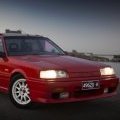Registration Questions (vic)
Announcements
-
Similar Content
-
Latest Posts
-
I said Garrett style. Not Garrett genuine. And something in the G30 550 range is what you want. Not those pokey little old fashioned T28 sized things. The intake ports in the head are small. There is little benefit in fattening up the runners and leaving ths actual ports small. Just run what you've got. And on the subject of Nistune vs Haltech etc..... You know you can control the transmission with decent standalone ECUs these days, right? No need to keep any of that old Nissan bullshit. Don't get me wrong - I use Nistune on my Neo. But it is a DET, so the number of bodges and workarounds I had to do to make it work in a chassis without ABS, TCS, etc, is quite small compared to the herniated arsehole you will have trying to make it work on a motor that doesn't have some of the things that the turbo ECU wants to see. Just easier to bite the bullet and go aftermarket outright.
-
Hmm. Only when the f**king thing is actually working. Still can't find the leak. And that's with dye being put in the last 3 times!
-
By R34_GT to Turbo · Posted
Ok so will run the piping over that radiator and no plenum it is. Put that money towards a Haltech and see what suits. Any ideas something like an elite 2000 or 2500 right? My long term goal is 300kw e85 and manual swap and that’s a dream come true. For now will be 200kw and auto the stock rb25det neo intake isn’t too expensive with throttle body. If I was to have the port matching done, Would that be better than the stock de intake as the det has bigger holes plus has the spots for sensors etc? And suit more long term? appreciate the advice? -
You understand AFR is not the only thing that contributes to it pinging yeah? Funnily, what the AFR gauge will tell you when it likely is pinging, is going to make you think things are really safe and good.







Recommended Posts
Create an account or sign in to comment
You need to be a member in order to leave a comment
Create an account
Sign up for a new account in our community. It's easy!
Register a new accountSign in
Already have an account? Sign in here.
Sign In Now